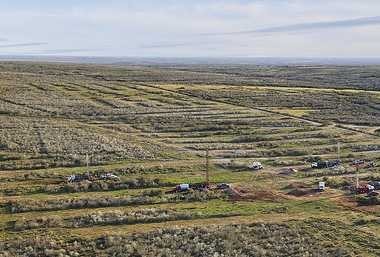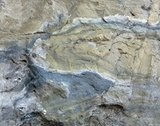DESCRIPTIVE MODEL OF SOLUTION-COLLAPSE
BRECCIA PIPE URANIUM DEPOSITS
By Warren I. Finch
<!--begin!kadov{{-->
BRIEF DESCRIPTION
<!--}}end!kadov--><!--kadov_tag{{<implicit_p>}}-->
SYNONYM: Collapse breccia pipe deposits,
sedimentary breccia pipe deposits, Orphan Lode-type
deposit.
<!--begin!kadov{{-->
DESCRIPTION: Uraninite and associated sulfide,
arsenide, sulfate, and arsenic-sulfosalt minerals as
disseminated replacements and minor fracture fillings
in distinct bodies in near-vertical cylindrical solution-
collapse breccia pipes, 30-175 m in diameter and
1,000 m in length. Pipes located in flat-lying upper
Paleozoic and Triassic rocks restricted to the Grand
Canyon region in the southwestern part of the
Colorado Plateau.
TYPICAL DEPOSITS: Orphan Lode (Chenoweth, 1986; Gornitz and others, 1988), EZ-2 (Krewedl and Carisey, 1986), Pigeon (Schafer, 1988) all in Arizona.
<!--begin!kadov{{-->
<!--}}end!kadov--><!--kadov_tag{{<implicit_p>}}-->
RELATIVE IMPORTANCE: One of two dominant high-
grade sources of United States uranium production in
1987; expected to be major source of future uranium
production within the United States.
<!--begin!kadov{{-->
<!--}}end!kadov--><!--kadov_tag{{<implicit_p>}}-->
COMMODITIES: U
<!--begin!kadov{{-->
<!--}}end!kadov--><!--kadov_tag{{<implicit_p>}}-->
OTHER COMMODITIES: ± Cu± V± Ag± Au
<!--}}end!kadov--><!--kadov_tag{{<implicit_p>}}-->
ASSOCIATED DEPOSIT TYPES (*suspected to be
genetically related): *Sandstone uranium; supergene
enrichment of Cu and V and depletion of U in deeply
eroded and weathered pipes--typical example,
Ridenour, Arizona (Chenoweth, 1988); Apex
germanium- and gallium-bearing breccia pipe nearby in
Basin and Range province (Wenrich and others, 1987).
<!--begin!kadov{{-->
<!--}}end!kadov--><!--kadov_tag{{<implicit_p>}}-->
REGIONAL GEOLOGIC ATTRIBUTES
<!--begin!kadov{{-->
<!--}}end!kadov--><!--kadov_tag{{<implicit_p>}}-->
TECTONOSTRATIGRAPHIC SETTING: Pipes found
within and along the southwest margin of the Colorado
Plateau, in a stable block existent since the
Precambrian and resistant to tectonic forces acting on
the western part of the North American plate. Wall
rocks of pipes were deposited on a stable marine
platform. Pipes apparently originated along and at
intersections of N. 50° E.- and N. 45° W.-trending joint
or fracture sets (Wenrich and Sutphin, 1989), roughly
parallel to orthogonal Colorado River (N. 45° E.), Zuni
(N. 45° W), and related lineaments shown by Green
(1988, fig. 4) that developed in the Precambrian and
rejuvenated in later periods. No igneous rocks are
found in the pipes.
<!--}}end!kadov--><!--kadov_tag{{<implicit_p>}}-->
REGIONAL DEPOSITIONAL ENVIRONMENT:
Breccia pipes developed from solution collapse within
the thick Mississippian Redwall Limestone (0-210 m)
beginning in the Late Mississippian and propagated
upward into overlying strata of carbonate-cemented
sandstone, siltstone, limestone, and conglomerate for
at least 1,000 m, apparently only where the Redwall is
>15 m thick. Stoping was intermittently active and
reached the lower members of the Chinle Formation in
Late Triassic time.
<!--}}end!kadov--><!--kadov_tag{{<implicit_p>}}-->
AGE RANGE: Host wall-rocks for pipes: Late
Mississippian to Late Triassic. Ores: 260-200 Ma
(Ludwig and Simmons, 1988).
<!--begin!kadov{{-->
<!--}}end!kadov--><!--kadov_tag{{<implicit_p>}}-->
LOCAL GEOLOGIC ATTRIBUTES
<!--begin!kadov{{-->
<!--}}end!kadov--><!--kadov_tag{{<implicit_p>}}-->
HOST ROCKS: Karst-collapse breccia. Breccia clasts
as wide as 10 m across, consisting mainly of
sandstone (~90 percent) and siltstone (~10 percent),
occur in a matrix of quartz grains that is commonly
well-cemented with carbonate minerals. Minor
claystone and limestone clasts.
<!--}}end!kadov--><!--kadov_tag{{<implicit_p>}}-->
ASSOCIATED ROCKS: Unbrecciated flat-lying
sandstone, siltstone, and limestone.
<!--begin!kadov{{-->
<!--}}end!kadov--><!--kadov_tag{{<implicit_p>}}-->
ORE MINERALOGY: Principal ore minerals:
uraninite±roscoelite+tyuyamunite*
+torbernite*+uranophane
*+zeunerite*+chalcopyrite+bornite*±chalcocite*±malachite*+azurite
*+brochantite *+volborthite+naumannite. Associated
base-metal minerals: ±sphalerite ±galena±bravoite±
rammelsbergite+stibnite +molybdenite+skutterudite.
An asterisk indicates sugergene origin. Pre-uraninite
mineral assemblages resemble those of Mississippi
Valley-type deposits. Unusual complexity of mineralogy
shown in appendix E.
<!--}}end!kadov--><!--kadov_tag{{<implicit_p>}}-->
GANGUE MINERALS:
Pyrite+marcasite+calcite+dolomite+barite+anhydrite±siderite
±hematite±limonite±goethite±pyrobitumen (see app.E).
<!--begin!kadov{{-->
<!--}}end!kadov--><!--kadov_tag{{<implicit_p>}}-->
TEXTURE AND MINERAL ZONING: Orebodies occur
as discontinuous pods mainly in the core of the
breccia pipe but some are also found in the annular-
ring structure and may occupy as much as a 200-m
vertical interval (fig. 20). Mainly replacement and
sparse open-space filling. Pyrite/marcasite and base-
metal sulfides, locally associated with pyrobitumen,
form a discontinuous "massive sulfide cap" above the
uranium deposits in many pipes. Uranium, vanadium,
and copper roughly zoned within some deposits.
ORE CONTROLS: Fractured, permeable rock within
breccia pipe. Nearly all primary ore confined to the
breccia pipe: rarely, a little uranium ore is reported in
relatively undisturbed beds outside the ring structure.
Vertically, most primary ore is below the Coconino
Sandstone and at the level of the Hermit Shale and the
Esplanade Sandstone of the Supai Group (fig. 20).
<!--}}end!kadov--><!--kadov_tag{{<implicit_p>}}-->
ISOTOPIC SIGNATURES: See Age Range above.
<!--begin!kadov{{-->
<!--}}end!kadov--><!--kadov_tag{{<implicit_p>}}-->
FLUID INCLUSIONS: Fluid-inclusion-filling
temperatures of 80-173°C for ore-related sphalerite,
dolomite, and calcite. Salinities (in weight percent NaCl
equivalent) are for sphalerite, [= or >] 9, for dolomite,
[= or >] 17, and for calcite, [= or >] 4 (Wenrich, 1985;
Wenrich and Sutphin, 1988).
<!--begin!kadov{{-->
<!--}}end!kadov--><!--kadov_tag{{<implicit_p>}}-->
STRUCTURAL SETTING: All ore associated with solution-collapse breccia pipes.
<!--begin!kadov{{-->
<!--}}end!kadov--><!--kadov_tag{{<implicit_p>}}-->
ORE DEPOSIT GEOMETRY: Orebodies develop in
annular-ring structures and in the core (fig. 20). At
Orphan Lode, orebodies in core range from 15 to 60
m in diameter and from 30 to 90 m high; annular-ring
orebodies are 5-20 m wide, and a few tens of meters
high, and extend variably part way around ring
circumference (Chenoweth, 1988).
<!--begin!kadov{{-->
<!--}}end!kadov--><!--kadov_tag{{<implicit_p>}}-->
ALTERATION: Characteristic bleaching by reduction
(some extends locally outward into wall rocks as
much as 30 m); common carbonate recrystallization
and calcification, local dolomitization and kaolinization,
some weak silicification. Calcified rock extends outside
boundary shears, completely surrounding the Orphan
Lode pipe. Malachite, azurite, goethite, and other
secondary minerals on surface outcrops of eroded
pipes.
<!--begin!kadov{{-->
<!--}}end!kadov--><!--kadov_tag{{<implicit_p>}}-->
EFFECT OF WEATHERING: Leaching of U and
enrichment of Cu and V, particularly in those pipes
deeply weathered. "Massive sulfide cap" apparently
prevented oxidation prior to erosion and exposure.
<!--}}end!kadov--><!--kadov_tag{{<implicit_p>}}-->
EFFECT OF METAMORPHISM: Not applicable.
<!--begin!kadov{{-->
GEOCHEMICAL SIGNATURES: Enrichment of Ag,
As, Ba, Cd, Co, Cr, Cs, Cu, Hg, Mo, Ni, Pb, Sb, Se,
Sr, U, V, Y, Zn, Zr, and REE; indicator elements are
Ag, As, Co, Cu, Ni, Pb, and Zn (Wenrich, 1985).
<!--begin!kadov{{-->
<!--}}end!kadov--><!--kadov_tag{{<implicit_p>}}-->
GEOPHYSICAL SIGNATURES: Electrical conductivity
and magnetic properties of the pipes are significantly
greater than for unbrecciated rocks; diagnostic
differences in conductivity shown by scalar
audiomagnetotelluric (AMT) and E-field telluric profile
data for one pipe (Flanigan and others, 1986). Ground
magnetometer surveys show subtle low magnetic
values over several pipes (Van Gosen and Wenrich,
1989).
<!--begin!kadov{{-->
<!--}}end!kadov--><!--kadov_tag{{<implicit_p>}}-->
SPATIAL EXPLORATION GUIDES: Collapse features
recognized by concentrically inward-dipping beds,
\circular concave topography, circular patches of
brecciated and (or) bleached or iron-stained rock
(related to "massive sulfide cap") and differences in
vegetation. In well-exposed areas of the Marble
Plateau, collapse breccia pipe densities are 0.11 pipes
per square kilometer. Marked tendency for pipes to
occur in clusters as small as 3 km2 in diameter. The
presence of one pipe indicates a high probability for
other pipes nearby.
<!--begin!kadov{{-->
<!--}}end!kadov--><!--kadov_tag{{<implicit_p>}}-->
OTHER EXPLORATION GUIDES: For a new area
\ outside of the Grand Canyon region, a thick (>15 m)
flat-lying, karst-forming limestone overlain by a thick
sequence of predominantly carbonate-cemented
sandstone and siltstone within a perpetually stable
cratonic environment and a post-pipe formation
volcanic source for uranium. Preexisting Mississippi
Valley-type Cu-Co-Ni-Pb-Zn sulfide-rich ore may be
required as a reductant for uranium deposition.
<!--}}end!kadov--><!--kadov_tag{{<implicit_p>}}-->
OVERBURDEN: Favorable area on Coconino Plateau
(fig. 20): depths to mineralized portion of pipes are
150-600 m. Area exposed on Esplanade surface (fig.
20): depths are 0-120 m. Additional cover by basalt, 0-
100 m thick, around San Francisco and Mt. Floyd
volcanic fields. Quaternary and Tertiary sediments, 0-
50 m thick, cover a few areas.
<!--begin!kadov{{-->
<!--}}end!kadov--><!--kadov_tag{{<implicit_p>}}-->
OTHER: Tectonic stability required for preservation.
"Massive sulfide cap" prevented and delayed oxidation
of some breccia pipe ores. Goethite possible
pathfinder mineral for recognition of concealed pipe.





 الموقع المقترح للمحطة النووية في الضبعة
الموقع المقترح للمحطة النووية في الضبعة 
